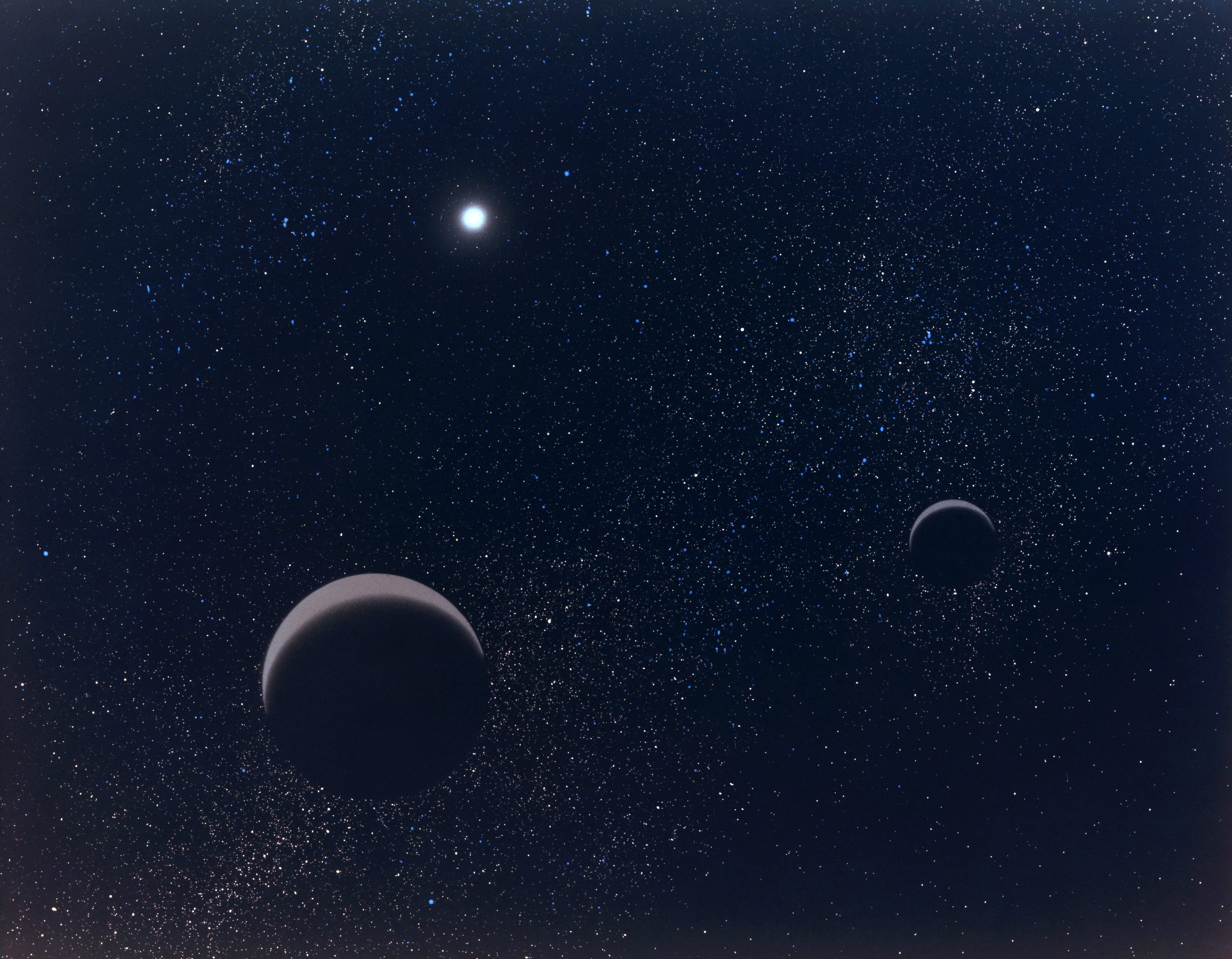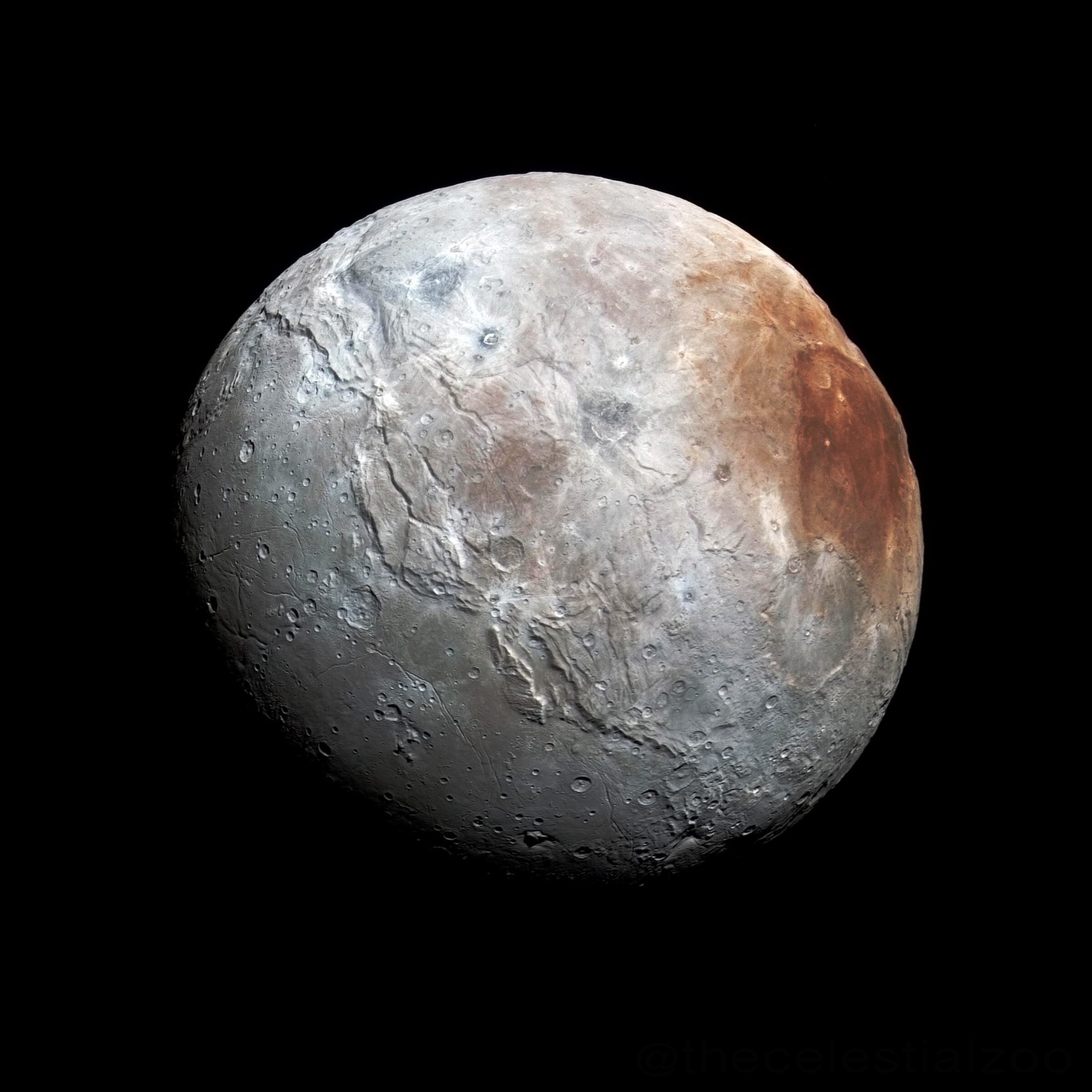
Planet Pluto by unknown Arthur/Wikimedia Commons
15 Facts about Planet Pluto
The word planet came from the ancient Greek words that mean wandering star. Pluto which was once a planet has interesting facts surrounding it, it’s now known as a dwarf planet. Pluto stopped being a planet in 2006 when it was reclassified as a dwarf planet, a demotion that attracted controversy and stirred debate in the scientific community and among the general public. Pluto is a dwarf planet in the Kuiper Belt, a donut-shaped region of icy bodies beyond the orbit of Neptune. Pluto has five moons, one of them, called Charon, is half of Pluto’s size. Pluto which is smaller than Earth’s Moon has a heart-shaped glacier that’s the size of Texas and Oklahoma. This fascinating world has blue skies, spinning moons, and mountains as high as the Rockies, and it snows but the snow is red. Pluto’s surface is composed of a mixture of frozen nitrogen, methane, and carbon monoxide ice. The dwarf planet also has polar caps and regions of frozen methane and nitrogen. Pluto has three known moons, Hydra, Nix, and Charon. The reason why Pluto is not a planet anymore the dwarf planet failed to meet the third condition. Its mass is substantially less than the combined mass of the other objects in its orbit 0.07 times, in contrast to Earth, which is 1.7 million times the remaining mass in the orbit, without the moon.
Here are interesting facts about Pluto
1. Interestingly the name Pluto came from an 11-year-old girl

Planet Pluto by NASA/Unsplash
An 11-year-old British girl is responsible for naming the planet Pluto, the once ninth planet of our solar system after her grandfather read about the dwarf planet’s discovery at the family breakfast table. Pluto may no longer be a planet. It may be small and obscure the swarf planet, but it is capable of captivating us with its hapless charm despite distance and darkness and years of scientists slowly chipping away at its status. Despite many rumors that Burney named the planet Pluto after the Greek god of the underworld or that the first two letters PL are in honor of Percival Lowell, the founder of Lowell Observatory, Burney seems to have named the planet Pluto because it sounded good to her. Burney, who became Venetia Phair after she was married, went on to become a schoolteacher and minor astronomy celebrity an asteroid has been named after her, it has a dust-measuring instrument on board New Horizons. She died in 2009, three years after the spacecraft launched and six years before it would reach the planet she named.
2. Amazingly the Dwarf Planet lay in the Kuiper belt

Kuiper belt by Paul Stansifer/Wikimedia Commons
The Kuiper belt is a disc of objects made of ice and rock that orbits our sun just past the orbit of Neptune. Pluto is the largest of the Kuiper Belt objects it is a collection of ice-rock bodies found beyond the reaches of Neptune’s orbit. The area is full of icy bodies and other dwarf planets at the edge of our solar system. Many Kuiper Belt objects have moons, and Pluto has five of its own Charon, Styx, Nix, Kerberos, and Hydra. Pluto is tidally locked with its largest moon, Charon, which is about half the dwarf planet’s diameter. The two worlds are cosmic tango partners, always showing the same face to one another. Tiny planets can hold a surprising range of features, from oceans and mountains to canyons, dunes, and volcanoes. Pluto was officially recognized as the ninth planet of the Solar System, it’s very cold on the planet.
3. Astonishingly Pluto is no longer a planet it is now known as the Dwarf planet

Planet Pluto by NASA/Unsplash
The IAU, an organization that governs international professional astronomical activities worldwide, determined a planet must meet three criteria: It orbits around the sun, it is a spherical shape and it is big enough that its gravity cleared away any other objects of similar size near its orbit, Pluto only meets two of the criteria required to be a planet. Our parents knew Pluto to be a planet now this new generation will consider Pluto as a dwarf planet. In August 2006 the International Astronomical Union downgraded the status of Pluto to that of the dwarf planet. The object formerly known as the planet Pluto was discovered on February 18, 1930, at the Lowell Observatory in Flagstaff, Arizona, by astronomer Clyde W. Tombaugh, with contributions from William H. Pickering. This period in astronomy was one of intense planet hunting. Astronomers believe there may be hundreds more undiscovered dwarf planets in the Kuiper Belt of the outer solar system. Pluto was not only voted out because of its size but also because it has not cleared its neighborhood around its orbit.
4. Pluto’s surface fascinatingly has mountains, valleys, plains, and craters

Pluto-Burney Basin-Craters Plains by Unknown Arthur/Wikimedia Commons
Pluto has many different characteristics including a diversity of surfaces and colors on the dwarf planet. Pluto has many mountains, craters, valleys, plains, and glaciers. Some of the regions of Pluto are dark and deep while others are bright as snow. Pluto is the only place other than Earth in our solar system that’s known to have white-peaked mountains, but these white caps aren’t made of snow, instead, they’re made of methane frost making it appear red instead of white. The appearance of the region is due to the fact that Pluto’s surface is extremely cold. The temperature is about negative 375°F, which is only 47F above absolute 0F. The nitrogen ice that makes up the surface in this region is less dense. The most prominent plains observed on Pluto appear to be made of frozen nitrogen gas and show no craters, the mountains get their brownish color from particles that come from Pluto’s haze.
5. The Dwarf planet will be remembered for its remarkable Tombaugh Regio

Tombaugh Regio by Unknown Arthur/Wikimedia Commons
Pluto is known to have an icy heart that was named Tombaugh Regio after Clyde Tombaugh, the American astronomer who discovered Pluto in 1930. Frozen nitrogen also covers part of Pluto’s surface in the shape of a heart. Tombaugh Regio in particular got a lot of attention because it is visually striking. Pluto’s heart spans a thousand kilometers, the eastern half crumbled with uplifted terrain and scraggly mountains, the western half smooth and plain. During the day, a thin layer of the nitrogen ice covering Tombaugh Regio warms and turns into vapor. At night, the vapor condenses and once again forms ice. Each sequence is like a heartbeat, pumping nitrogen winds around the dwarf planet. The heart’s right lobe is comprised of highlands and nitrogen-rich glaciers that extend into the basin.
6. The astonishing Pluto planet has a thin tenuous atmosphere

Planet Pluto by unknown Arthur/Wikimedia Commons
Pluto is not close to the Sun its 3.7 billion miles away, its surface ice sublimates changing directly from solid to gas and rising to temporarily form a thin atmosphere, it’s known as perihelion, the atmosphere freezes solid, and when it is at aphelion, the surface temperature increases, causing the ices to sublimate. Pluto’s low gravity about 6% of Earth’s causes the atmosphere to be much more extended in altitude than our planet’s atmosphere. Pluto’s atmosphere, already on the thin side, is made up largely of nitrogen with a few dabs of methane and carbon monoxide. Pluto’s atmosphere is created from the vaporized ice on the surface, with small changes in temperature leading to significant changes in the bulk density of the atmosphere. Pluto’s atmosphere provides a blue tint to the haze, a particularly interesting feature of Pluto’s atmosphere is the very rapid rate at which it escapes to space. Pluto was close to the sun than Neptune between 1979 to 1999.
7. Pluto is extremely cold and no form of life can exist
The surface of Pluto is extremely cold, so it seems unlikely that life could exist there. At such cold temperatures, water, which is vital for life as we know it, is essentially rock-like. Pluto’s interior is warmer, however, and some think there could even be an ocean deep inside. The average temperature of Pluto’s surface is about -370 to -400 °F. It is only about 60 °F away from absolute zero, making it extremely difficult for any type of organism to live there. The main reason for these low temperatures is the dwarf planet’s distance from the Sun. Pluto also features an immense body primarily consisting of nitrogen ice. This body of ice made scientists believe Pluto may be hosting a 60-mile-deep subsurface ocean, not only does water freeze solid at these temperatures, but other liquids and gases that are present on Pluto’s surface such as methane, nitrogen gas, and carbon monoxide also freeze solid. There is simply no way life could survive on the surface of Pluto, between the extreme cold, low atmospheric pressure, and constant changes in the atmosphere, no known organism could survive.
8. Interestingly Pluto spins in the opposite direction of the earth

Planet Pluto by NASA/Unsplash
In the solar system, all orbits are circular apart from the dwarf planets Pluto’s orbit is very different. Pluto’s orbit is radically different from those of the other planets, which follow nearly circular orbits around the Sun close to its equator, Pluto’s orbit on the other hand is projected outward It’s highly elliptical, traveling around the Sun in a squashed circle, the orbit is highly inclined, traveling at an angle of 17-degrees. Despite the fact that Pluto’s orbit often crosses with that of Neptune’s, their orbits are aligned in a way that they never collide nor get too close to each other. Pluto varies so widely, it can switch places with Neptune, orbiting closer to the Sun. The last time this happened was on February 7, 1979. This strange orbit gives Pluto some unusual characteristics, sometimes bringing it within the orbit of Neptune. Pluto takes two hundred and forty-eight years to complete one full orbit around the Sun. During this journey, the orbit of Pluto ranges in distance from the Sun following an elliptical orbit. The nature of Pluto’s orbit is an enduring mystery.
9. Fascinatingly Pluto is smaller than the moon

Full Moon by Luc Viatour/Wikimedia Commons
Pluto is about two-thirds the diameter of Earth’s Moon and probably has a rocky core surrounded by a mantle of water ice. Interesting ices like methane and nitrogen frost coat the surface. Pluto’s newly estimated size means that its density is slightly lower than previously thought, and the fraction of ice in its interior is slightly higher. Also, the lowest layer of Pluto’s atmosphere, called the troposphere, is shallower than previously believed. Earth has a diameter of 7,918 miles, making it more than five times the size of Pluto, Pluto is about 40 times farther from the sun than Earth is. Pluto has less gravity than Earth. This means a person would weigh much less on Pluto than on Earth.
10. Unbelievably Pluto has five moons and Charon is the largest

Pluto and Charon by Unknown Arthur/Wikimedia Commons
Pluto is said to have five moons Charon, Styx, Nix, Kerberos, and Hydra. Charon is huge if it weren’t orbiting Pluto, it would be the sixth-largest dwarf planet in the entire Solar System. The four smaller moons orbit in circular paths, with Pluto and Charon orbiting together. Pluto’s largest moon, Charon, was first discovered in 1978 when an observer at the Naval Observatory captured an image of what looked almost like a bump growing out the side of Pluto. It’s about half the size of Pluto, and its surface is mostly grayish with mottled areas of reddish material near one pole. That polar material is made up of a substance called tholin, which is made up of methane or ethane molecules, sometimes combined with nitrogen ice and reddened by constant exposure to solar ultraviolet light.
11. Charon the largest moon orbiting the dwarf planet

Charon moon by Pablo Carlos/ Wikimedia Commons
Charon is the largest of the five moons in orbit around the dwarf planet Pluto. They are located beyond Neptune in a vast region called the Kuiper Belt, a huge collection of rocks, dust, and other dwarf planets orbiting the sun. Charon is one-half the size of Pluto making it proportionally the largest moon in the solar system. Note that Pluto and Charon are much closer in size than Earth and its moon. The moon’s diameter is roughly the size of Texas, the surface is grayish-white in color. The history behind the name of the largest of the five moons orbiting planet Pluto, Charon was named after the mythical ferryman of Hades who carried the souls of the newly deceased across the rivers Styx and Acheron which divided the world of the living from the world of the dead a surprising red formation at Charon’s northern pole. The reddish hue comes from Pluto’s atmosphere, Pluto itself is too small to hold onto its atmosphere for its lifetime, so the nitrogen, methane, and carbon monoxide leave the surface. Close-orbiting Charon captures some of the material, which is then funneled toward the surface.
12. Amazingly Pluto is one of the largest Dwarf planets
Many may ask what is a Dwarf Planet. According to the International Astronomical Union, which sets definitions for planetary science, a dwarf planet is a celestial body that -orbits the sun, has enough mass to assume a nearly round shape, has not cleared the neighborhood around its orbit, and is not a moon. The best-known dwarf planet, Pluto is also the largest in size and the second largest in mass. Pluto has five moons. Pluto is one of the largest known members of the Kuiper Belt, the surface of Pluto features large plains, glaciers, and mountains of nitrogen and water ice, including a distinctively shaped glacier that resembles the left hemisphere of a heart. Pluto has just 0.2% of the Earth’s mass, and its mass is about a tenth that of the Moon’s.
13. The famous Clyde Tombaugh discovered the astonishing planet Pluto

Clyde W. Tombaugh by Unknown Arthur/Wikimedia Commons
Clyde Tombaugh who was just 25 years old at the time was working at Lowell Observatory in Flagstaff, Arizona discovered the planet, Pluto, on February 18th, 1930. During this time, technology wasn’t advanced enough to see how big Pluto was or to notice the other bodies beyond Neptune Tombaugh had been working at the observatory for about a year. The astronomer was fascinated with the stars from a young age and discovered Pluto before he had even attended college. The existence of an unknown ninth planet was first proposed by Percival Lowell, who theorized that wobbles in the orbits of Uranus and Neptune were caused by the gravitational pull of an unknown planetary body. Pluto used to be the ninth planet in our solar system until the International Astronomical Union created a new system for classifying space objects in 2006. After the discovery of Pluto, Tombaugh received a scholarship to study astronomy at the University of Kansas. He began as a freshman in 1932 and continued to work in astronomy for many years. Tombaugh was later known as one of only a few scientists to take UFOs seriously. He died in 1997, mercifully before the demotion of his planet to the status of a dwarf.
14. The amazing colors of planet Pluto
Before new inventions, one could not tell the true colors of planet Pluto but now with the new technology scientist can tell the color of Pluto. The most accurate natural color images of Pluto were taken by NASA’s New Horizons spacecraft in 2015. Pluto is mostly brown; Pluto’s brown color is thought dominated by frozen methane deposits metamorphosed by faint but energetic sunlight. The dark band below Pluto’s equator is seen to have rather a complex coloring, however, indicating that some unknown mechanisms may have affected Pluto’s surface. Color images of Pluto released by NASA in 2015 show the dwarf planet has a reddish-brown surface, but an even newer photo shows that despite those colors, Pluto’s atmosphere has a blue haze. Scientists attribute the color disparity to tholins, particles formed after sunlight sparks chemical reactions between nitrogen and methane in the atmosphere. The process was first seen on Titan, Saturn’s moon; in the case of Pluto, the particles are likely gray or red but they scatter blue light, making it the most visible to the human eye.
15. The New Horizon spacecraft carried the ashes of the astonishing astronomist Clyde Tombaugh

Astronomist by Unknown Arthur/Unsplash
Tombaugh’s ashes were aboard NASA’s New Horizons spacecraft when it launched from Cape Canaveral Air Force Station, Florida, in January 2006. Carrying the ashes of the famous astronomist who discovered the planet Pluto, carried in a small canister on the spacecraft, traveled with New Horizons on a nine-year, three-billion-mile journey to Pluto. The spacecraft flew past Pluto and its five moons on July 14th, 2015, coming to within 7,800 miles of the surface and delivering the now iconic images of Pluto and its heart, as well as all five of its moons: Charon, Nix, Hydra, Styx, and Kerberos. The flyby revolutionized humankind’s understanding of the Pluto system and dwarf planets.
Planning a trip to Paris ? Get ready !
These are Amazon’s best-selling travel products that you may need for coming to Paris.
Bookstore
- The best travel book : Rick Steves – Paris 2023 – Learn more here
- Fodor’s Paris 2024 – Learn more here
Travel Gear
- Venture Pal Lightweight Backpack – Learn more here
- Samsonite Winfield 2 28″ Luggage – Learn more here
- Swig Savvy’s Stainless Steel Insulated Water Bottle – Learn more here
Check Amazon’s best-seller list for the most popular travel accessories. We sometimes read this list just to find out what new travel products people are buying.










